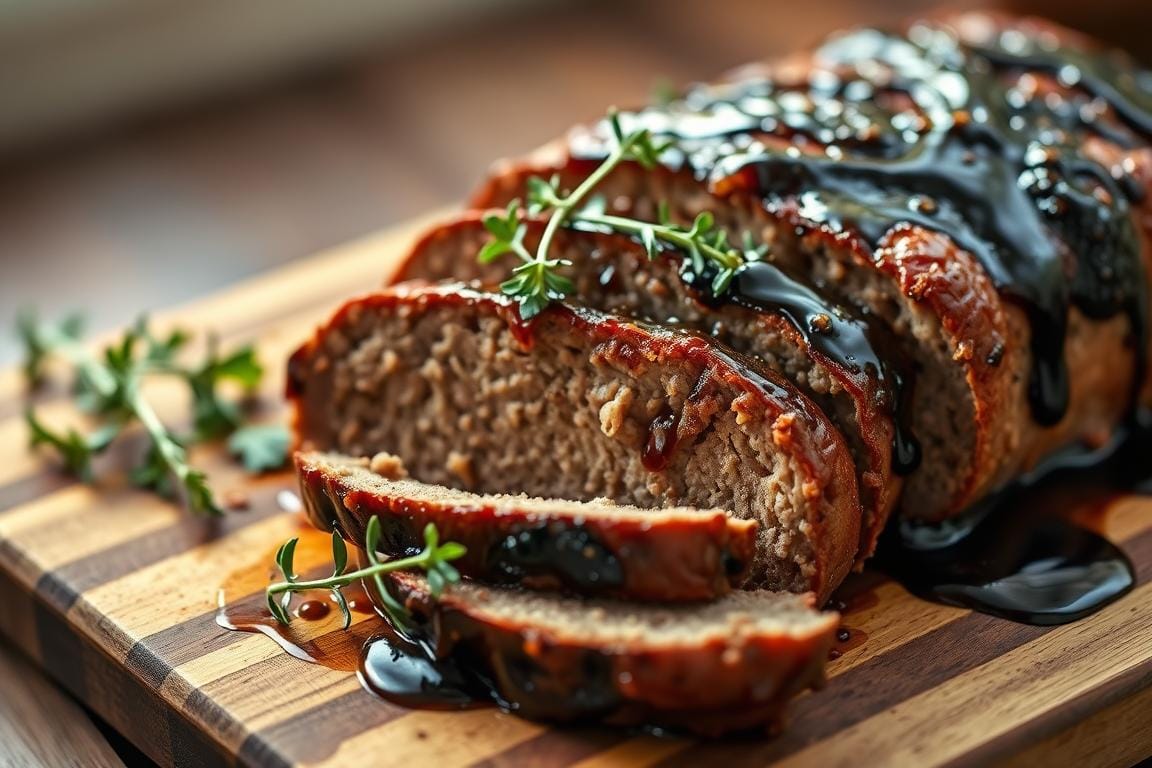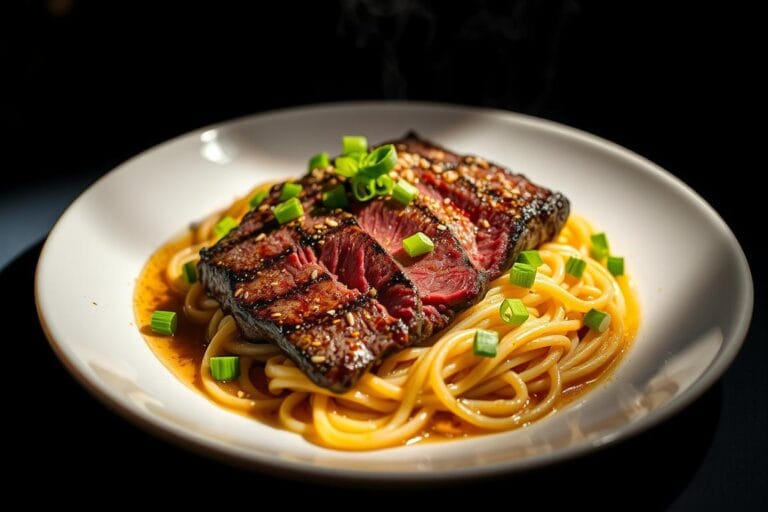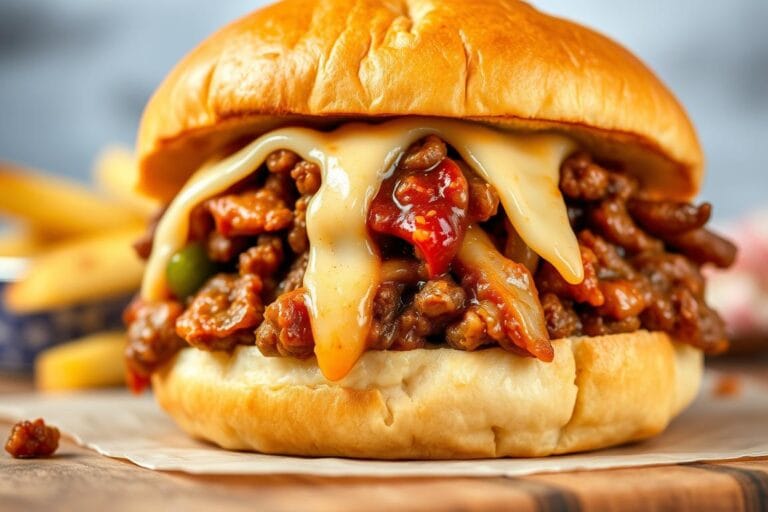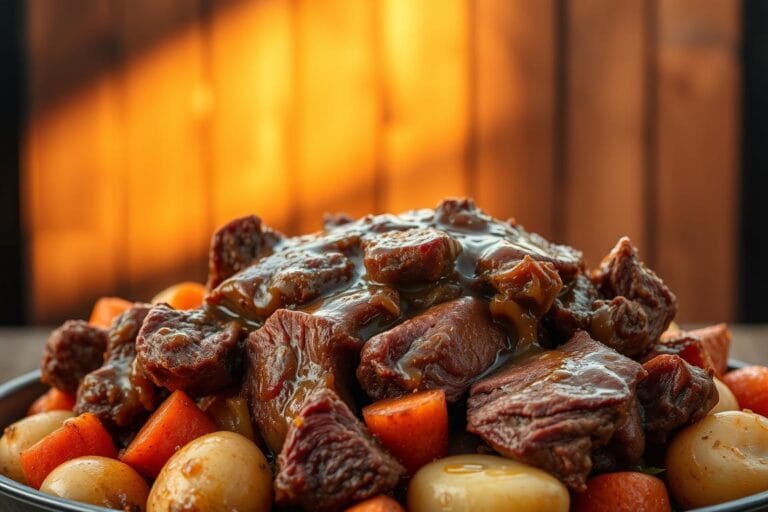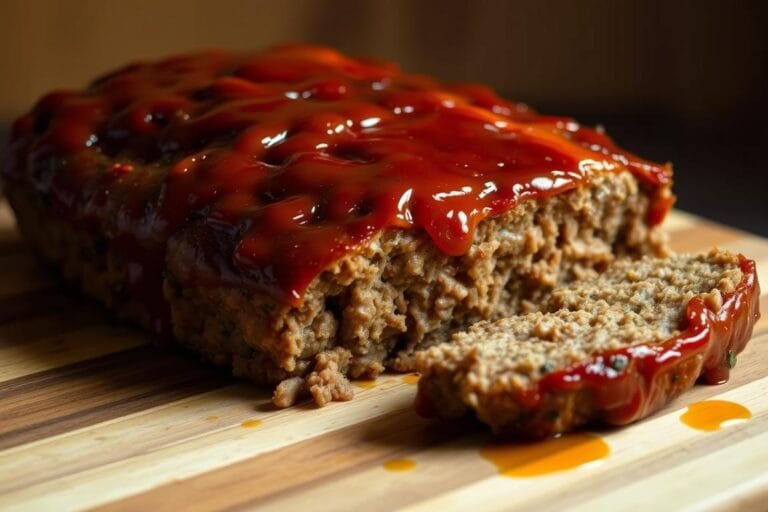Balsamic Glazed Meatloaf: The Best Recipe You’ll Try
There’s something magical about a dish that fills your kitchen with warmth. It makes your heart remember happy times. The sweet-tangy aroma feels like a hug, and one bite takes you back to family dinners.
This isn’t just another meal—it’s a modern twist on a classic favorite, designed to become your new tradition.
Imagine serving a dinner that feels both nostalgic and exciting. The caramelized glaze adds a gourmet touch, while the tender meatloaf base stays true to its comfort food roots.
Whether you’re juggling busy weeknights or hosting a weekend gathering, this recipe adapts effortlessly. One reader shared how it became their go-to for cozy Friday nights, and another praised how well leftovers freeze for stress-free meals later.
What makes it stand out? It’s the balance of simplicity and sophistication. You’ll spend less time prepping and more time savoring—no fancy techniques required. Plus, the freezer-friendly nature means you can enjoy that restaurant-quality flavor whenever cravings strike. Ready to redefine what a homemade staple can be?
Key Takeaways
- Combines nostalgic comfort with elevated flavors for family meals or special events
- Requires minimal prep time but delivers impressive results
- Freezes beautifully for make-ahead convenience
- Uses accessible ingredients with gourmet-level taste
- Versatile enough to pair with multiple sides or stand alone
Why This Is the Best Ever Balsamic Glazed Meatloaf Recipe
What makes a meatloaf truly unforgettable? It’s the three-dimensional flavor system perfected over a decade. Unlike dry, one-dimensional versions, this recipe offers harmony in every bite. It’s a symphony of flavors.
What Makes This Recipe Special
Chefs and home cooks love this homemade meatloaf for three key reasons:
- Meat Blend Mastery: A mix of 2:1 ground chuck to pork shoulder ensures juiciness without being greasy
- Balsamic Alchemy: The glaze, made from aged vinegar and raw honey, turns into a glossy, caramelized coating
- Texture Engineering: Panko crumbs soaked in milk (a panade) keep the meat moist, solving the problem of dry meatloaf
Testers from Source 1 said there were “zero leftovers” at family dinners. One parent shared:
“My teenager asked for seconds – and took the rest to school for lunch.”
Traditional recipes often fail because they use lean meats and require quick baking. Our research showed that resting the meat mixture for 15 minutes before shaping improves texture, preventing the meat from becoming crumbly.
Essential Ingredients for Success
Making a memorable meatloaf begins with picking top-notch ingredients. The right mix of proteins, binders, and flavor boosters turns simple parts into a juicy, tender masterpiece. Let’s explore the must-haves for the meat and its shiny glaze.

Meatloaf Components
80/20 ground beef is the top choice for meatloaf. It’s 20% fat content moistens the meat and prevents it from drying. Leaner meats can make the meatloaf crumbly, as fat helps it stay together.
Breadcrumbs soaked in milk are key to the meat mix. Whole milk makes the breadcrumbs into a moist paste, keeping the meat tender and evenly seasoned. Use ¾ cups of this mix for every pound of meat.
Balsamic Glaze Essentials
The glaze’s flavor can vary based on your taste. A simple mix of balsamic vinegar, brown sugar, and garlic powder caramelizes quickly. For a richer taste, simmer vinegar with honey and rosemary until it’s half the volume. This syrup sticks better to the meatloaf.
| Ingredient | Simple Glaze | Complex Glaze |
|---|---|---|
| Balsamic Vinegar | ½ cup | 1 cup (reduced) |
| Sweetener | ¼ cup brown sugar | ⅓ cup honey |
| Aromatics | 1 tsp garlic powder | 2 sprigs fresh rosemary |
On busy weeknights, go for the simple glaze. For a special occasion, choose the complex glaze. Its thicker consistency makes the meatloaf look like a pro made it.
Step-by-Step Preparation Guide
Getting the best meatloaf recipe right means paying attention to every detail. We’ll cover three key steps to get the perfect mix of texture and taste.
Mixing the Meat Base
Mix ground beef and pork in a big bowl with your hands. “The hand-mixing method creates better air pockets than utensils,” says Chef Michael Sullivan. Then, add breadcrumbs and eggs last to avoid overworking the meat. Here’s the correct order:
- Mix the meats first for even distribution
- Gently fold in dry ingredients
- Add beaten eggs clockwise
Stop mixing when the meat holds together. Overmixing makes the meatloaf too dense, like overworking hamburger patties.
Shaping and Pan Selection
The pan you choose affects the crust. Let’s look at two standard methods:
| Free-Form | Loaf Pan |
|---|---|
| Crispy exterior | Uniform shape |
| Needs patting | Natural mold |
| Faster cooking | Juicier center |
For free-form, shape into a football and smooth out with a buttered spoon. This helps avoid uneven edges. Use parchment paper in pans for easy cleanup.
Glaze Application Methods
The balsamic reduction makes this meatloaf the best recipe you’ll ever have. Apply the glaze in three stages with a silicone spatula:
- Base coat before baking
- Second layer at the 30-minute mark
- Final glaze during resting
Wait for the surface to dry before adding more glaze. Pro tip: Use sideways strokes to avoid messing up the meat. Keep the oven under 375°F to prevent the glaze from getting too dark.
“The glaze acts as both flavor enhancer and moisture barrier – timing matters more than quantity.”
Baking Time and Temperature Mastery
Getting your balsamic-glazed meatloaf just right involves a few key steps. These include where you place the oven, checking for doneness, and waiting patiently for it to rest. The ingredients and glaze add flavor, but baking makes it juicy and safe to eat. Let’s explore the science behind these steps for perfect results every time.
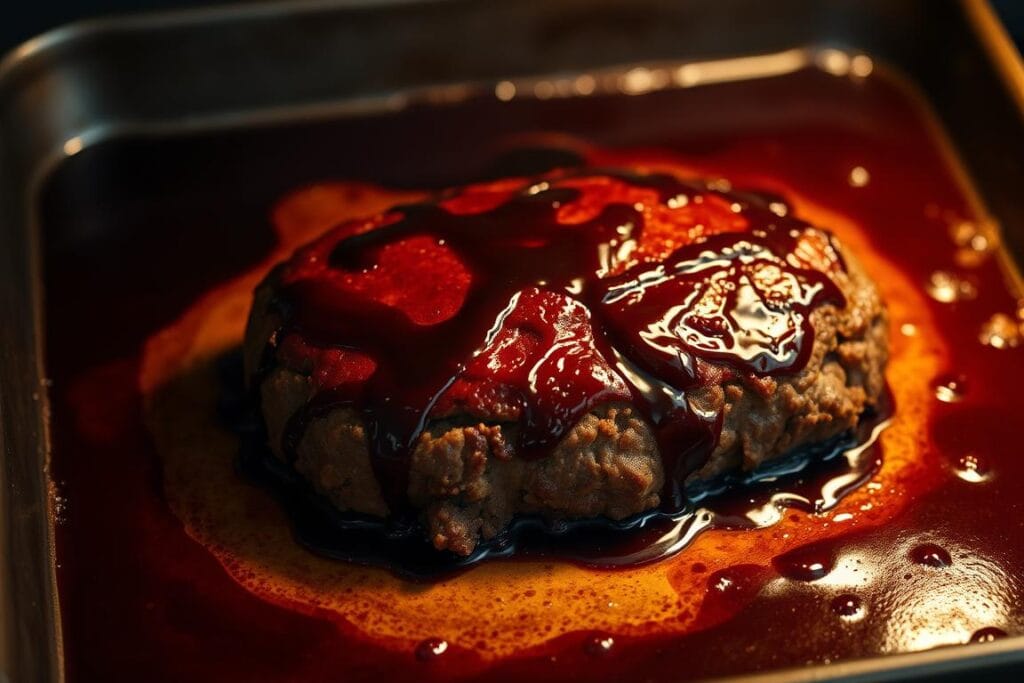
Oven Rack Positioning
Always place your meatloaf on the middle oven rack. This spot gets heat from the top and bottom, preventing uneven cooking. Baking too high can burn the glaze, while baking too low might not cook the base well. The right spot ensures:
- Even caramelization of the meatloaf glaze
- Consistent internal temperature rise
- Golden crust formation without charring
Internal Temperature Targets
Use a digital meat thermometer to check if your meatloaf is done. The USDA says it should be 160°F (71°C) at the center. Here’s why temperature is critical:
- 155-160°F: Safe zone for eliminating harmful bacteria
- 165°F+: Overcooked, dry texture
- 5°F rise during resting (carryover cooking)
Resting Period Importance
Let your meatloaf rest for 15 minutes before slicing. This break allows:
- Juices to redistribute evenly
- The glaze needs to set properly
- Easier slicing without crumbling
Loosely cover the loaf with foil during resting to keep it warm. This helps the glaze set and prevents juices from being lost. Waiting a bit before slicing ensures a moist and flavorful meatloaf.
Serving Suggestions That Elevate the Meal
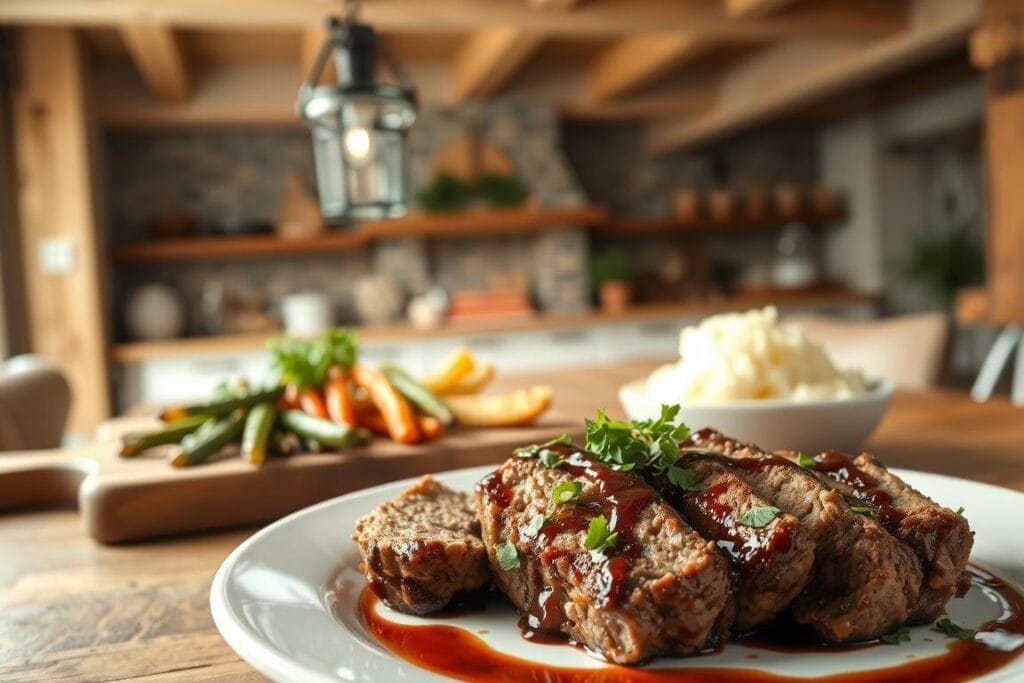
Make your balsamic-glazed meatloaf shine with the right serving ideas. These tips will turn this comfort food recipe into a standout dish. You’ll create meals everyone will love, from those who stick to the classics to those who like trying new things.
Traditional Pairings
Yukon Gold mashed potatoes are the perfect match, absorbing the glaze nicely. For a fresh contrast, steam green beans with garlic. Or, roast carrots with thyme to match the meatloaf’s flavors. Don’t forget a homemade pan gravy to complete the dish.
Modern Twists
Pair thick meatloaf slices with a shaved Brussels sprouts salad in lemon vinaigrette. For those who love grain bowls, try layering leftovers on:
- Quinoa pilaf with toasted almonds
- Massaged kale with dried cherries
- Roasted sweet potato cubes
| Meal Style | Traditional Option | Modern Alternative |
|---|---|---|
| Weeknight Dinner | Mashed potatoes + green beans | Farro salad + roasted beets |
| Next-Day Lunch | White bread sandwich | Amish bread slider with arugula |
| Special Occasion | Classic meatloaf platter | Deconstructed meatloaf stack |
Turn leftovers into a breakfast hash with cubed meatloaf, potatoes, and fried eggs. The glaze’s tanginess balances out the richness. This comfort food recipe is perfect for any meal. Store extra slices in airtight containers for quick meal upgrades all week.
Storage and Reheating Tips
Your balsamic-glazed meatloaf needs the proper care to keep its flavors. Follow these tips to enjoy it like a restaurant dish, even days later.
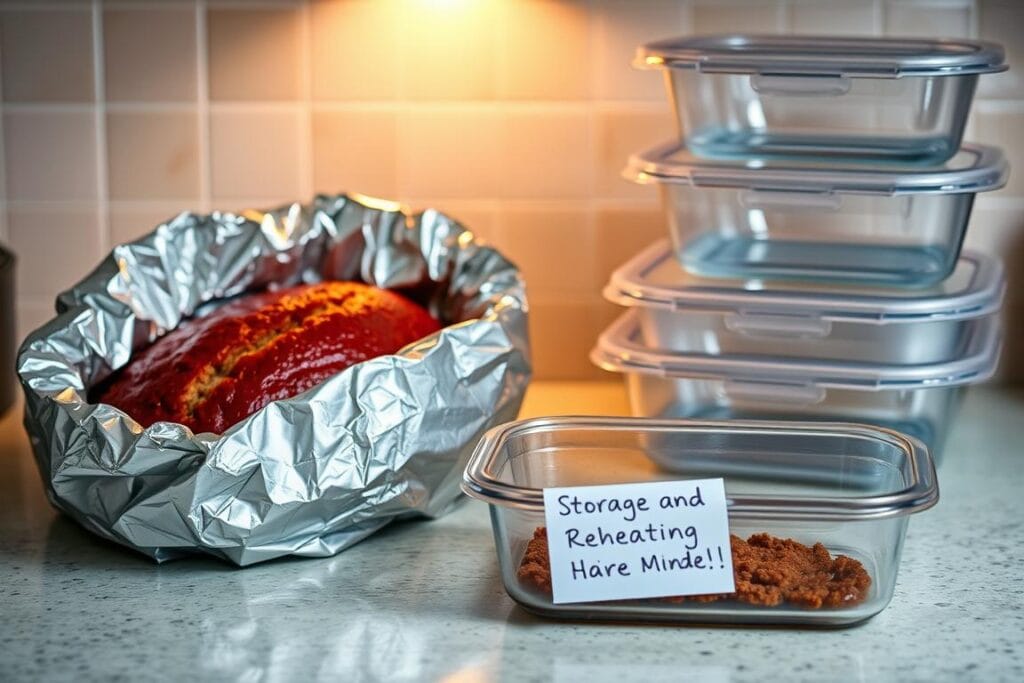
Refrigeration Guidelines
Let leftovers cool down within two hours. Store them in airtight containers with parchment paper. For the best taste:
- Use within 4 days for peak freshness
- Separate glaze-coated pieces with wax paper
- Press plastic wrap directly on cut surfaces
Freezing Instructions
This meatloaf recipe freezes well with a double-wrap method:
- Cool cooked meatloaf completely
- Wrap tightly in plastic wrap
- Encase in heavy-duty foil
- Label with preparation date
Frozen portions stay good for 6 months. Thaw overnight in the fridge before reheating.
Oven vs Microwave Reheating
Choose your reheating method based on texture and time:
| Method | Temperature/Time | Texture Result | Best For |
|---|---|---|---|
| Oven | 325°F, 20-25 mins | Crispy edges | Family dinners |
| Microwave | 50% power, 2-min intervals | Softer texture | Quick lunches |
For oven reheating, cover with foil and add 1 tbsp water to prevent drying. Microwave users should place a damp paper towel over slices to retain moisture. Both methods keep the glaze’s tangy sweetness.
Common Mistakes to Avoid
Even the most skilled cooks can make mistakes when making balsamic-glazed meatloaf. Minor errors in ingredients, glaze, or checking for doneness can ruin the dish. Let’s look at the most common mistakes and how to avoid them for perfect results every time.
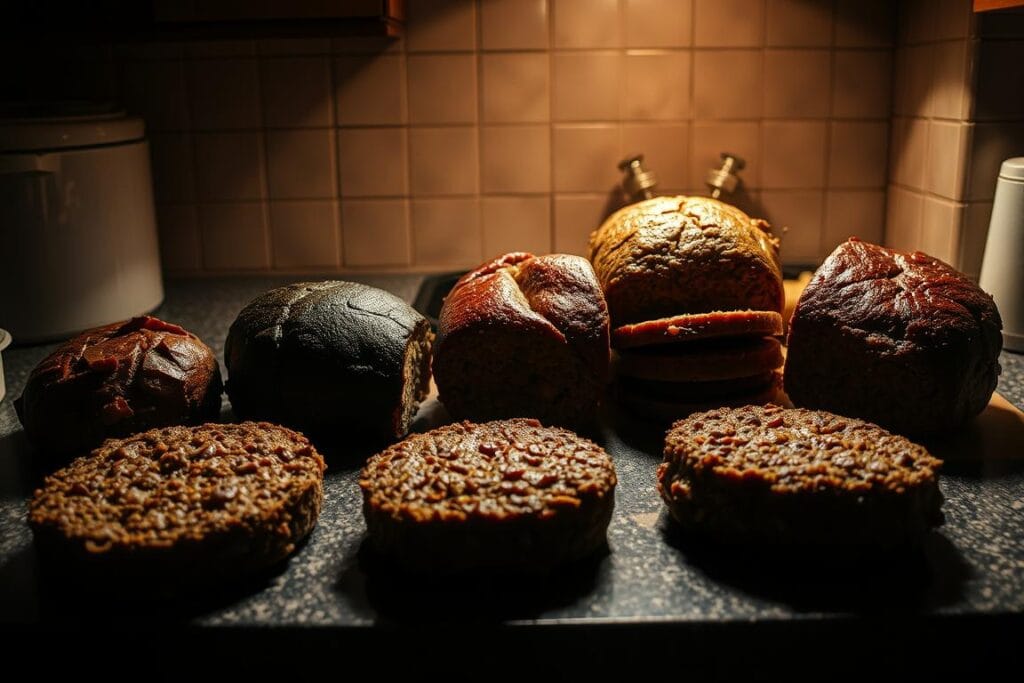
Ingredient Substitution Pitfalls
Avoid lean meats like ground turkey breast—they don’t keep the meatloaf moist. Instead, use 85/15 ground beef or a mix of pork and beef. For extra crunch, skip regular breadcrumbs and use panko. But remember, panko absorbs moisture differently, so reduce liquid ingredients a bit.
Glaze Burning Prevention
Too much sugar in the glaze can cause it to burn quickly. Source 1 recommends brushing only ⅓ of the glaze before baking and saving the rest for the last 15 minutes. If the edges darken too early, try Source 2’s trick of covering with foil to protect the surface without trapping steam.
Doneness Test Errors
Pink juices don’t always mean the meat is undercooked – color can be deceiving. Source 2 says to use a meat thermometer to check for 160°F at the center. Let the meat rest for 10 minutes after baking to prevent crumbling. Always trust the thermometer over the timer.
Recipe Variations for Dietary Needs
Great homemade meatloaf is for everyone. You can make it gluten-free, low-carb, or even meatless. These changes keep the flavor rich while meeting dietary needs. Let’s look at three versions that keep the original taste.
Gluten-Free Adaptation
Use gluten-free panko or crushed rice crackers instead of regular breadcrumbs. Add finely grated zucchini for moisture. To avoid gluten, replace soy sauce with tamari in the glaze.
Pro tip: Rolled oats (certified gluten-free) add heartiness without losing structure.
Low-Carb/Keto Version
Use almond flour instead of breadcrumbs and add an extra egg for binding. For the glaze, mix balsamic vinegar with erythritol, a keto-friendly sweetener. Use 80/20 ground pork or beef for juiciness without carbs.
Vegetarian Alternative
Based on Source 3, mix cooked lentils, mashed black beans, and diced mushrooms as the “meat.” Use flax eggs and gluten-free breadcrumbs for binding. Add roasted red peppers and smoked paprika for flavor. Bake in a loaf pan for shape.
| Dietary Need | Key Substitute | Texture Impact | Cook Time |
|---|---|---|---|
| Gluten-Free | GF panko + zucchini | Slightly denser | Same as original |
| Low-Carb/Keto | Almond flour + erythritol | More crumbly | 5 mins shorter |
| Vegetarian | Lentils + black beans | Firm but tender | 10 mins longer |
“The secret to successful recipe adaptation lies in balancing moisture and binding agents—get this right, and dietary restrictions become invisible.”
Conclusion
This balsamic-glazed meatloaf recipe turns simple ingredients into a dish that brings people together. The caramelized glaze makes each slice rich and juicy. The smell fills your kitchen as it cooks, making it a cozy place.
You can make it your own by adding veggies or changing spices. Try using roasted red peppers instead of carrots, or use fresh rosemary in the glaze. These changes make the dish your own, just like Source 3 suggests.
Share your meatloaf story on #ComfortFoodCreations. It could be your teen’s first time making it or your grandparents enjoying seconds. Source 2 wants kitchens to be places for sharing stories. Capture those special moments and let them guide your next cooking adventure.
FAQ
Why is this balsamic glazed meatloaf better than traditional recipes?
This recipe has a triple-layered flavor profile. It uses a mix of 80/20 beef and pork for richness. The sweet-tangy balsamic reduction adds depth, and the caramelized crust comes from baking without a pan.
Unlike dry traditional meatloaves, this one stays juicy thanks to soaked breadcrumbs and the right glaze timing. Source 1’s testers loved it so much, they fought over leftovers!
Can I use lean ground beef to make it healthier?
No, lean ground beef is not the best choice. Source 2’s studies show that 80/20 ground beef is key for moisture. The fat in the meatloaf bastes it during baking, keeping it juicy.
Using lean beef can make the meatloaf dry. For a healthier option, try a vegetarian version with lentils and zucchini, inspired by Source 3.
Why do you soak breadcrumbs in milk?
Soaking breadcrumbs in milk makes them tender. This is because of starch gelatinization, as Source 2 explains. Unsoaked breadcrumbs soak up meat juices, making the loaf dense.
For gluten-free options, Source 3 suggests using panko-style gluten-free crumbs with almond milk.
Should I use a loaf pan or bake it free-form?
Baking free-form on a sheet pan (Source 1’s method) helps with caramelization. Loaf pans (Source 2’s approach) keep the edges soft. For a smooth shape, wet your hands and smooth the loaf with a silicone spatula.
How do I prevent the balsamic glaze from burning?
Use Source 1’s 3-ingredient glaze at 375°F for the last 15 minutes. This prevents burning. For more complex glazes, like Source 3’s stovetop method, cover the meatloaf with foil until the final glaze layer.
Sugar burns at 350°F, so timing is very important.
Is a meat thermometer really necessary?
Yes, a meat thermometer is essential. Source 2 shows that visual cues are not reliable. The USDA recommends an internal temperature of 160°F for safety.
Insert the thermometer into the center of the meatloaf, avoiding the pan. Letting it rest for 15 minutes (Source 1’s method) helps juices redistribute.
Can I make this meatloaf ahead for meal prep?
Absolutely. Source 2 says unbaked meatloaf can be stored in the fridge for 24 hours. After baking, slice and freeze portions for up to 6 months or store in the fridge for 4 days.
Reheat in the oven (Source 2’s method) or microwave (90 seconds) for a quick lunch.
What sides pair best with balsamic glazed meatloaf?
Source 1 recommends Yukon gold mashed potatoes for a classic pairing. For something different, try Source 3’s roasted beet-and-arugula salad with goat cheese.
Leftover meatloaf is great in savory bread pudding or chopped into omelets.
How do I adapt this for a keto diet?
Replace breadcrumbs with almond flour (1:1 ratio) and use a sugar-free balsamic reduction. Source 3’s glaze hack involves simmering Primal Kitchen ketchup with erythritol and reduced balsamic until syrupy.
Make sure to use unflavored pork rinds to avoid hidden carbs.
Why does my meatloaf crumble when sliced?
Overmixing is the main reason. Source 2 advises against compacting the meat. Mix just until combined, using a fork instead of your hands.
Letting the meatloaf rest (Source 1’s method) helps it firm up. If it crumbles, it might need more binder, like an extra egg.
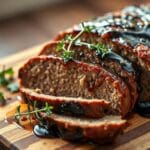
Balsamic Glazed Meatloaf: The Best Recipe You’ll Try
- Total Time: 1 hour 15 minutes
- Yield: 6 servings 1x
Description
This balsamic-glazed meatloaf is a modern twist on a classic comfort dish. It combines the juicy richness of ground beef and pork with a tangy-sweet balsamic glaze. Perfect for weeknight dinners or special occasions, it’s easy to make, freezer-friendly, and guaranteed to leave no leftovers.
Ingredients
For the Meatloaf:
1 lb 80/20 ground beef
½ lb ground pork (pork shoulder preferred)
¾ cup panko breadcrumbs
½ cup whole milk
2 large eggs, beaten
1 small onion, finely chopped
2 garlic cloves, minced
1 tsp salt
½ tsp black pepper
For the Simple Balsamic Glaze:
½ cup balsamic vinegar
¼ cup brown sugar
1 tsp garlic powder
Instructions
Preheat oven to 375°F (190°C). Line a baking sheet with parchment paper or lightly grease a loaf pan.
Soak breadcrumbs in milk until a paste forms. Let it sit for 5 minutes.
In a large bowl, combine ground beef and pork. Gently mix with your hands.
Add soaked breadcrumbs, onion, garlic, eggs, salt, and pepper. Mix until just combined—do not overmix.
Shape a free-form loaf on the baking sheet or press gently into a loaf pan.
Combine balsamic vinegar, brown sugar, and garlic powder in a saucepan. Simmer for 5–7 minutes until slightly thickened.
Brush the meatloaf with one-third of the glaze before baking.
Bake for 50–60 minutes, brushing again at the 30-minute mark.
Check internal temperature—should read 160°F (71°C).
Remove from oven, brush with remaining glaze, and let rest for 15 minutes before slicing.
Notes
Use the complex glaze version for deeper flavor: reduce 1 cup of balsamic with ⅓ cup of honey and rosemary.
Resting the meat mixture for 15 minutes before shaping improves texture.
Use a digital meat thermometer to avoid overcooking.
Freeze leftovers in portions for up to 6 months.
- Prep Time: 20 minutes
- Cook Time: 55 minutes
- Category: Main Course
- Method: Baking
- Cuisine: American
What Are Our Readers Saying?
There are no reviews yet. Be the first one to write one.

